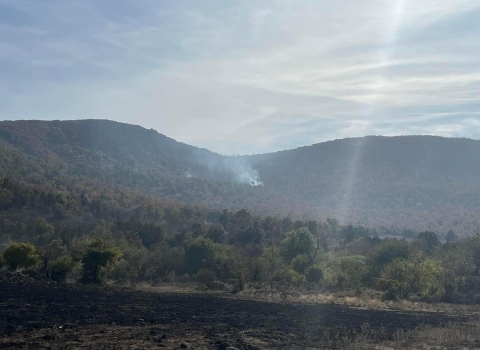Press Release
Draft Comprehensive Conservation Plan for Klamath Marsh NWR Available for Public Review
Tulelake, Calif., -- The U.S. Fish and Wildlife Service today announced that the Klamath Marsh National Wildlife Refuge (NWR) Draft Comprehensive Conservation Plan (CCP) and Environmental Assessment (EA) is available for review and comment.
The Klamath Marsh NWR protects habitat for waterfowl and other unique wetland and aquatic dependent species, including the greater sandhill cranes, yellow rails, Oregon spotted frogs, red-naped sapsuckers, pygmy nuthatches, bald eagles, beaver, and red band trout.
Public meetings on the draft plan are scheduled for August 18 from 6:30 -8:30 pm at the Klamath Falls Shilo Inn (ballroom), 2500 Almond St., Klamath Falls, OR 97601; and, on August 19 from 6:30 -8:30 pm at the Chiloquin Community Center, 216 1st. Ave., Chiloquin, OR 97624.
Written comments on the draft plan must be received at the address below on or before Friday, September 18, 2009.Comments should be sent to Mark Pelz, Chief, Refuge Planning, 2800 Cottage Way, W-1832, Sacramento, CA, 95825, phone (916) 414-6500.
The purpose in developing a CCP is to provide refuge managers with a 15-year plan for achieving refuge purposes and contributing toward the mission of the National Wildlife Refuge System, consistent with sound principles of fish and wildlife management, conservation, legal mandates, and our policies.
CCPs also identify wildlife-dependent recreational opportunities available to the public, including opportunities for hunting, fishing, wildlife observation and photography, environmental education and interpretation.
The Klamath Marsh NWR was established in 1958 and is located in south central Oregon on the east slope of the Cascade Mountain Range along the Williamson River. The Service owns approximately 40,960 acres within the 49,583-acre acquisition boundary. The Refuge protects one of the largest remaining natural freshwater marshes on the west coast.
Other important habitats on the refuge include sedge meadow, grassland, riverine, riparian riparian
Definition of riparian habitat or riparian areas.
Learn more about riparian scrub, and ponderosa pine forest. The refuge protects habitat for a variety of unique species including greater sandhill cranes, yellow rails, Oregon spotted frogs, red-naped sapsuckers, pygmy nuthatches, bald eagles, beaver, and red band trout. The entire Refuge is located within the former reservation of the Klamath Tribes.
The Draft CCP/EA identifies three alternatives for how the Refuge will be managed over the next 15 years. The Service
The Klamath Marsh NWR protects habitat for waterfowl and other unique wetland and aquatic dependent species, including the greater sandhill cranes, yellow rails, Oregon spotted frogs, red-naped sapsuckers, pygmy nuthatches, bald eagles, beaver, and red band trout.
Public meetings on the draft plan are scheduled for August 18 from 6:30 -8:30 pm at the Klamath Falls Shilo Inn (ballroom), 2500 Almond St., Klamath Falls, OR 97601; and, on August 19 from 6:30 -8:30 pm at the Chiloquin Community Center, 216 1st. Ave., Chiloquin, OR 97624.
Written comments on the draft plan must be received at the address below on or before Friday, September 18, 2009.Comments should be sent to Mark Pelz, Chief, Refuge Planning, 2800 Cottage Way, W-1832, Sacramento, CA, 95825, phone (916) 414-6500.
The purpose in developing a CCP is to provide refuge managers with a 15-year plan for achieving refuge purposes and contributing toward the mission of the National Wildlife Refuge System, consistent with sound principles of fish and wildlife management, conservation, legal mandates, and our policies.
CCPs also identify wildlife-dependent recreational opportunities available to the public, including opportunities for hunting, fishing, wildlife observation and photography, environmental education and interpretation.
The Klamath Marsh NWR was established in 1958 and is located in south central Oregon on the east slope of the Cascade Mountain Range along the Williamson River. The Service owns approximately 40,960 acres within the 49,583-acre acquisition boundary. The Refuge protects one of the largest remaining natural freshwater marshes on the west coast.
Other important habitats on the refuge include sedge meadow, grassland, riverine, riparian riparian
Definition of riparian habitat or riparian areas.
Learn more about riparian scrub, and ponderosa pine forest. The refuge protects habitat for a variety of unique species including greater sandhill cranes, yellow rails, Oregon spotted frogs, red-naped sapsuckers, pygmy nuthatches, bald eagles, beaver, and red band trout. The entire Refuge is located within the former reservation of the Klamath Tribes.
The Draft CCP/EA identifies three alternatives for how the Refuge will be managed over the next 15 years. The Service


